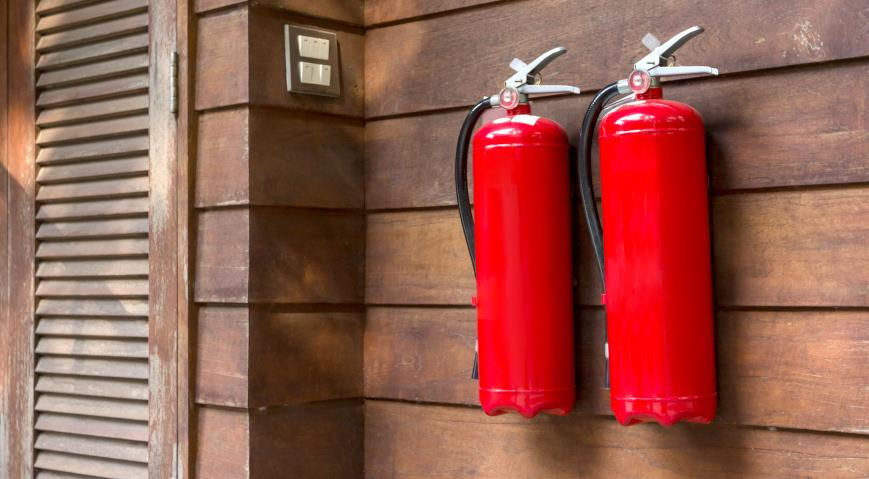Fire extinguishers are crucial safety devices designed to control or extinguish small fires in emergency situations. However, to ensure their effectiveness, proper maintenance is essential. Neglecting fire extinguisher maintenance can lead to equipment failure when it is needed most. This article explores the maintenance rules for fire extinguishers, outlining regulatory requirements, inspection procedures, servicing guidelines, and best practices for keeping them in optimal condition.
NOTE :- Fire Extinguishers were strategically installed and tested by Sensor Techuae to safeguard workplaces and residential areas from fire hazards. Ensure your safety today! Reach out for expert fire protection solutions.
Regulatory Requirements for Fire Extinguisher Maintenance
Fire extinguisher maintenance is governed by various safety standards and regulations. The most widely recognized standards include:
- NFPA 10 (National Fire Protection Association): Establishes guidelines for the selection, use, maintenance, and inspection of portable fire extinguishers.
- OSHA (Occupational Safety and Health Administration): Mandates that workplaces comply with fire extinguisher inspection and maintenance regulations.
- Local Fire Codes: Different regions may have specific fire safety regulations that dictate maintenance requirements.
Failure to comply with these regulations can result in penalties, increased liability, and heightened fire risks.
Routine Inspection of Fire Extinguishers
Regular inspections are critical to ensuring that fire extinguishers remain in proper working condition. These inspections should be performed by trained personnel and documented for compliance purposes.
Monthly Inspections
A visual inspection should be conducted at least once a month to check for:
- Proper Placement: Ensure the extinguisher is easily accessible and mounted in its designated location.
- Physical Condition: Look for visible signs of damage, such as dents, corrosion, or leakage.
- Pressure Gauge Readings: The needle should be within the green zone, indicating proper pressure levels.
- Tamper Seals and Pins: Verify that safety seals and locking pins are intact to prevent accidental discharge.
- Legible Labels and Instructions: The operating instructions should be clearly visible and easy to read.
Annual Inspections
In addition to monthly checks, fire extinguishers must undergo a comprehensive annual inspection performed by a certified professional. This inspection ensures compliance with regulatory standards and identifies any necessary servicing or replacements.
Servicing and Maintenance Procedures
Routine servicing and maintenance extend the life of fire extinguishers and ensure their effectiveness. These tasks should be carried out by certified fire protection professionals.
Recharging Fire Extinguishers
Fire extinguishers that have been partially or fully discharged must be recharged immediately. Recharging involves:
- Refilling the extinguisher with the appropriate fire suppressant.
- Repressurizing the unit to the recommended level.
- Conducting a leak test to verify proper sealing.
Hydrostatic Testing
Hydrostatic testing evaluates the structural integrity of fire extinguisher cylinders. It involves:
- Filling the extinguisher with water or another testing fluid.
- Applying high pressure to assess the cylinder’s ability to withstand stress.
- Checking for leaks, weaknesses, or deformations.
Different types of fire extinguishers have specific hydrostatic testing intervals:
- Dry Chemical Extinguishers: Every 12 years
- CO2 and Water-Based Extinguishers: Every 5 years
- Halotron Extinguishers: Every 6 years
Replacement of Expired Fire Extinguishers
Fire extinguishers have a limited lifespan, typically ranging from 10 to 20 years, depending on the manufacturer and type. Signs that indicate a need for replacement include:
- An expired manufacturer’s label
- Excessive corrosion or rust
- Malfunctioning pressure gauge
- Recurrent leakage or discharge failures
Proper Storage and Handling of Fire Extinguishers
Proper storage and handling contribute to the longevity and functionality of fire extinguishers. Guidelines include:
- Mounting at the Correct Height: According to OSHA, extinguishers should be mounted no higher than 5 feet above the ground for easy accessibility.
- Protecting from Extreme Temperatures: Exposure to extreme heat or cold can impact extinguisher performance.
- Securing Against Physical Damage: Use protective cabinets or brackets to prevent accidental damage.
Employee Training and Fire Safety Awareness
Maintenance efforts are only effective if individuals know how to use fire extinguishers correctly. Employers should provide:
- Fire Extinguisher Training: Employees should learn how to operate extinguishers using the PASS method (Pull, Aim, Squeeze, Sweep).
- Fire Safety Drills: Regular fire drills enhance preparedness and reinforce safety protocols.
- Proper Usage Guidelines: Emphasize when and how to use an extinguisher based on fire classifications (Class A, B, C, D, and K).

Common Mistakes in Fire Extinguisher Maintenance
Avoiding common maintenance mistakes ensures fire extinguishers remain reliable. Frequent errors include:
- Skipping Monthly Inspections: Increases the risk of unnoticed defects.
- Ignoring Low Pressure Levels: Can render the extinguisher ineffective.
- Using Incorrect Extinguishers for Certain Fires: Mismatched extinguishers may worsen the situation.
- Failing to Replace Expired Units: Old extinguishers may not function properly during an emergency.
Conclusion
Maintaining fire extinguishers is a crucial aspect of fire safety that ensures these lifesaving devices are ready for use in emergencies. By following regulatory guidelines, conducting regular inspections, performing necessary servicing, and providing employee training, businesses and homeowners can uphold fire safety standards effectively. Regular maintenance not only enhances fire protection but also minimizes risks and ensures compliance with safety regulations.
For more insightful articles related to this topic, feel free to visit – bdnews55